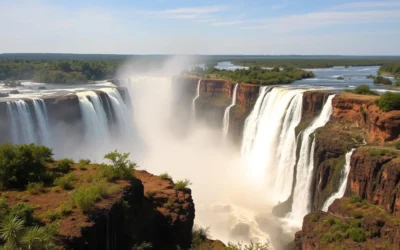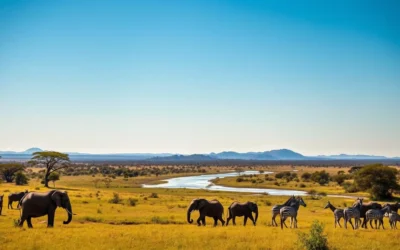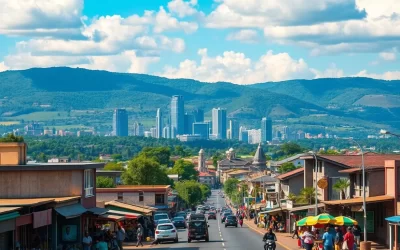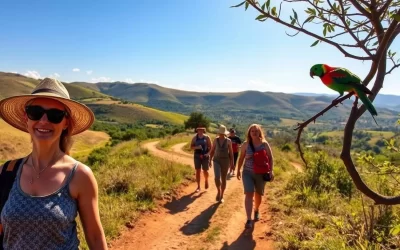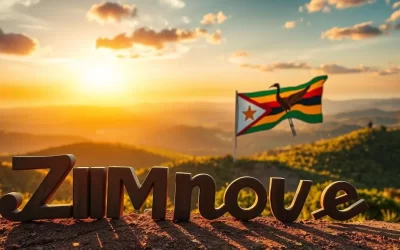✓ Accommodations✓ Flights✓ Rental Cars
Did you know that Bulawayo is a train transit hub connecting Zimbabwe to neighboring countries like South Africa, Botswana, and the majestic Victoria Falls? This significant transportation role is just one aspect of what makes Bulawayo a fascinating travel destination.
Bulawayo, the second-largest city in Zimbabwe, is steeped in history and culture, earning it the nickname “City of Kings.” As you explore this vibrant place, you’ll discover a diverse range of attractions, from UNESCO World Heritage sites to captivating museums and breathtaking natural wonders.
This guide will help you make the most of your experience in Bulawayo, providing insider tips and recommendations on the top things to see and do. With its unique blend of colonial architecture, African culture, and natural beauty, Bulawayo is an ideal base for exploring southern Zimbabwe.
Discovering Bulawayo: Zimbabwe’s Second City
Bulawayo, often overshadowed by its more famous counterparts, is a city that will captivate your senses. As you explore this laid-back place, you’ll uncover a rich tapestry of history, culture, and natural beauty.
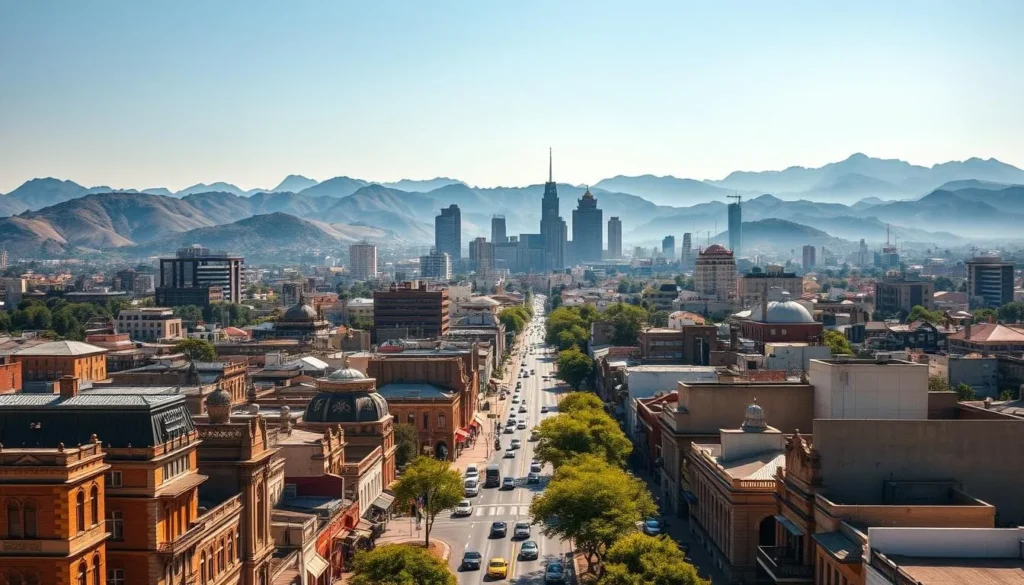
A Brief History of the “City of Kings”
Bulawayo’s history dates back to the 19th century when it was founded by King Lobengula, the last king of the Ndebele people. The city’s name, which means “place of slaughter,” reflects its turbulent past. Over time, Bulawayo has evolved into a vibrant city that proudly preserves its heritage.
The city’s historic significance is evident in its architecture, museums, and cultural festivals. Visitors can experience the city’s rich history by visiting landmarks such as the Bulawayo Railway Museum and the Natural History Museum.
| Landmark | Description |
|---|---|
| Bulawayo Railway Museum | Showcases historic locomotives and carriages, including Cecil Rhodes’ personal carriage |
| Natural History Museum | Features an impressive taxidermy collection and exhibits on Zimbabwe’s geology and mineral resources |
Why Bulawayo Deserves Your Attention
Bulawayo offers an authentic Zimbabwean experience that’s distinct from more touristy areas. The city’s cultural scene is thriving, with numerous art galleries, theaters, and music venues showcasing local talent. When you visit Bulawayo, you’ll have the opportunity to engage in various things to do, from exploring museums to experiencing the city’s vibrant cultural scene.
- Explore the city’s rich cultural heritage
- Visit world-class museums like the Natural History Museum
- Use Bulawayo as a gateway to spectacular natural attractions like Matobo National Park
In conclusion, Bulawayo is a city that offers a unique blend of history, culture, and natural beauty, making it an ideal destination for travelers seeking an authentic Zimbabwean experience.
Matobo National Park: A UNESCO World Heritage Site
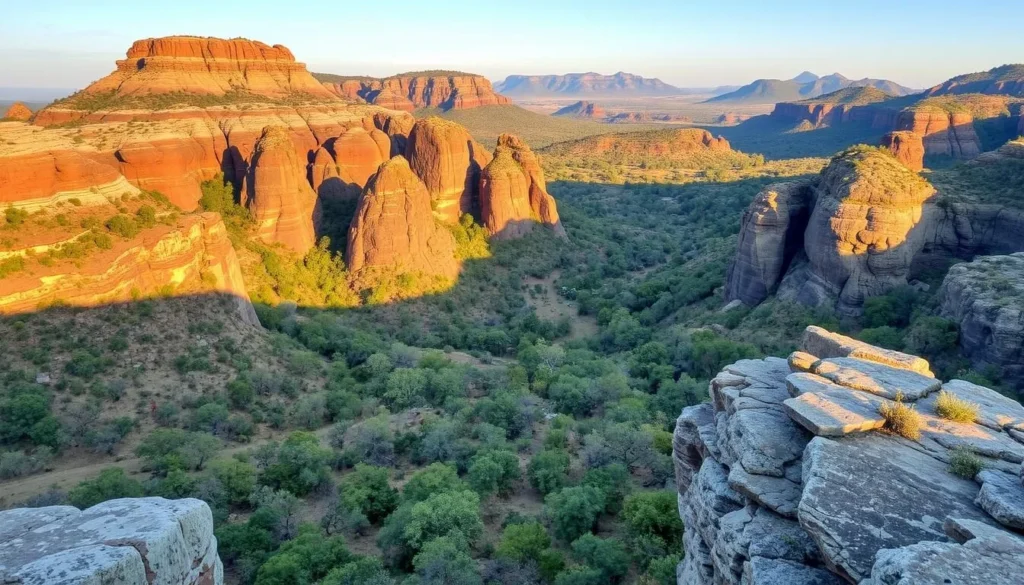
Matobo National Park, a UNESCO World Heritage Site, is a treasure trove of natural beauty and history. Located approximately 40km from Bulawayo off the Matopos Rd, the park is well-signposted, making it easily accessible for visitors. As you enter the park, you’ll be struck by the unique granite landscapes and diverse wildlife that call this place home.
Granite Landscapes and Rock Formations
The park’s granite landscapes are a result of millions of years of erosion, creating breathtaking rock formations that are not only visually stunning but also hold significant cultural and historical importance. As you explore the park, you’ll have the opportunity to witness these natural wonders up close.
Wildlife Viewing and Rhino Tracking
Matobo National Park is home to a diverse range of wildlife, including the endangered black rhino. Visitors can enjoy guided rhino tracking tours, providing a unique opportunity to observe these magnificent creatures in their natural habitat. The park’s varied landscape supports a wide variety of flora and fauna, making it a paradise for nature lovers.
Rhodes’ Grave and Sunset Views
One of the park’s most significant historical sites is Rhodes’ Grave, the final resting place of Cecil John Rhodes. Visitors can pay their respects and enjoy breathtaking sunset views from this vantage point. To access Rhodes’ Grave, an additional fee of about $4 is required, which contributes to the conservation efforts within the park.
Practical Information for Visitors
Before planning your visit, it’s essential to know that the park is open from 6am to 6pm. The entrance fee is US $4 for locals and $15 for tourists. Visitors are advised to bring water, sun protection, and appropriate clothing. The park offers various facilities, including restrooms and picnic areas, making it a family-friendly destination. To make the most of your visit, consider allocating at least half a day to explore the park’s many wonders.
For those traveling to Bulawayo, Matobo National Park is an unmissable attraction. With its rich history, stunning landscapes, and diverse wildlife, the park offers an unforgettable experience. Whether you choose to travel Bulawayo by self-drive, taxi, or organized tour, Matobo National Park is sure to leave a lasting impression.
Natural History Museum: Zimbabwe’s Finest Collection
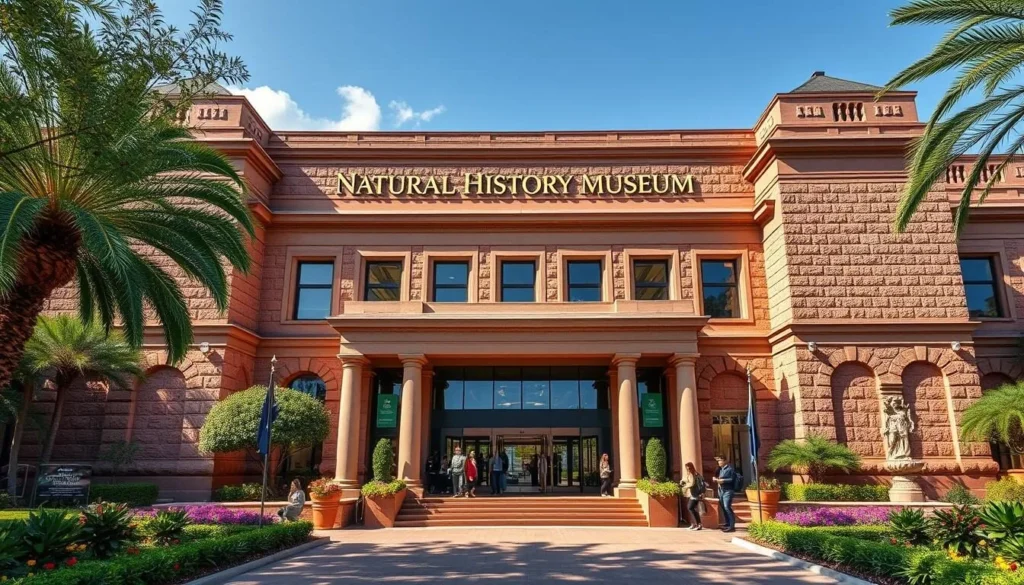
As you step into the Natural History Museum, you’re about to embark on a fascinating journey through time. The museum is home to Zimbabwe’s finest collection of natural history specimens and artifacts, offering a comprehensive look at the country’s rich heritage.
The Impressive Taxidermy Collection
The museum boasts an impressive taxidermy collection, featuring a wide range of Zimbabwean wildlife. From majestic lions to graceful antelopes, the exhibits showcase the country’s diverse fauna. You’ll be amazed by the lifelike displays, which provide a unique glimpse into the natural world.
The taxidermy collection is not just about showcasing animals; it’s also an educational tool that highlights the importance of conservation. By presenting the animals in their natural habitats, the museum encourages visitors to appreciate the beauty and complexity of Zimbabwe’s ecosystems.
Geology and Mineral Exhibits
The geology and mineral exhibits are another highlight of the museum. You’ll discover a vast array of minerals and rocks, including some that are native to Zimbabwe. The exhibits provide valuable insights into the country’s geological history and the processes that have shaped its landscape over millions of years.
These exhibits are not just visually striking; they also offer a wealth of information about the geological processes that have shaped Zimbabwe. From the formation of the Earth’s crust to the creation of mineral deposits, the exhibits provide a comprehensive overview of the country’s geological heritage.
Zimbabwe’s History Through Artifacts
The museum’s “Mankind” section takes you on a journey through Zimbabwe’s history, from the Stone Age to the colonial era. You’ll see a range of artifacts, including Stone Age tools, ancient pottery, and colonial-era items. These exhibits provide a fascinating glimpse into the lives of Zimbabwe’s indigenous peoples and the cultural evolution of the region.
Some of the highlights include a rare Dodo egg and one of the first-ever caught Coelacanths, a pre-historic fish species thought to have been extinct for millions of years. You’ll also learn about Syntarsus, a distinctive dinosaur species discovered in Zimbabwe. These artifacts bring Zimbabwe’s rich history to life, providing a unique perspective on the country’s cultural and natural heritage.
Bulawayo Railway Museum: A Journey Through Time
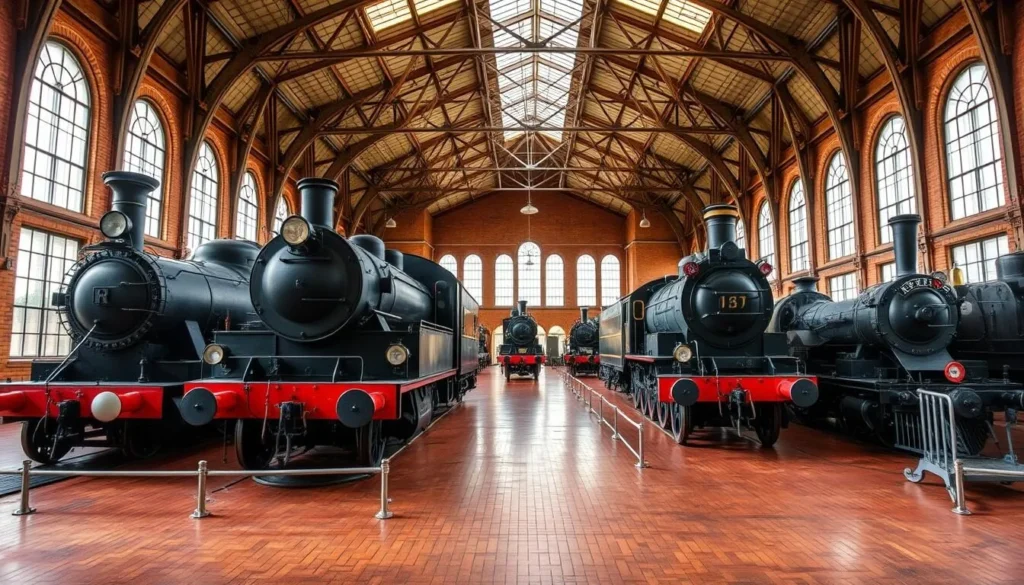
Step back in time and explore the rich railway heritage at the Bulawayo Railway Museum. Located in the city centre behind Bulawayo Railway Station on Prospect Avenue, this museum is a must-visit for anyone fascinated by the history of rail transport.
Cecil Rhodes’ Personal Carriage
One of the museum’s most prized exhibits is the personal railway carriage of Cecil Rhodes, the founder of Rhodesia. This luxurious carriage offers a glimpse into the opulence of the late 19th century and highlights Rhodes’ significant role in the region’s history.
Historic Locomotives and Engines
The museum boasts an impressive collection of historic locomotives and engines, showcasing the evolution of steam and diesel technology. Visitors can marvel at the intricate details and craftsmanship of these machines, which played a crucial role in the development of Zimbabwe’s railway network.
How to Get There and What to Expect
The Bulawayo Railway Museum is open daily from 8 am to 4:30 pm, making it an ideal destination for visitors of all ages. The entrance fee is around US $2, making it an affordable and family-friendly activity. You can reach the museum by walking from various parts of the city centre or by taking a taxi. The museum is equipped with basic facilities, including restrooms. It’s advisable to bring a camera, water, and sun protection if you plan to explore the outdoor exhibits. The museum’s Facebook page provides updated information, and self-guided materials are available for those who prefer to explore at their own pace.
Visiting the Bulawayo Railway Museum is an excellent way to spend a day, especially if you’re interested in history, technology, or simply want to enjoy a unique experience. With its extensive collection and affordable entrance fee, it offers excellent value for money.
Mzilikazi Arts and Crafts Centre: Local Artistry
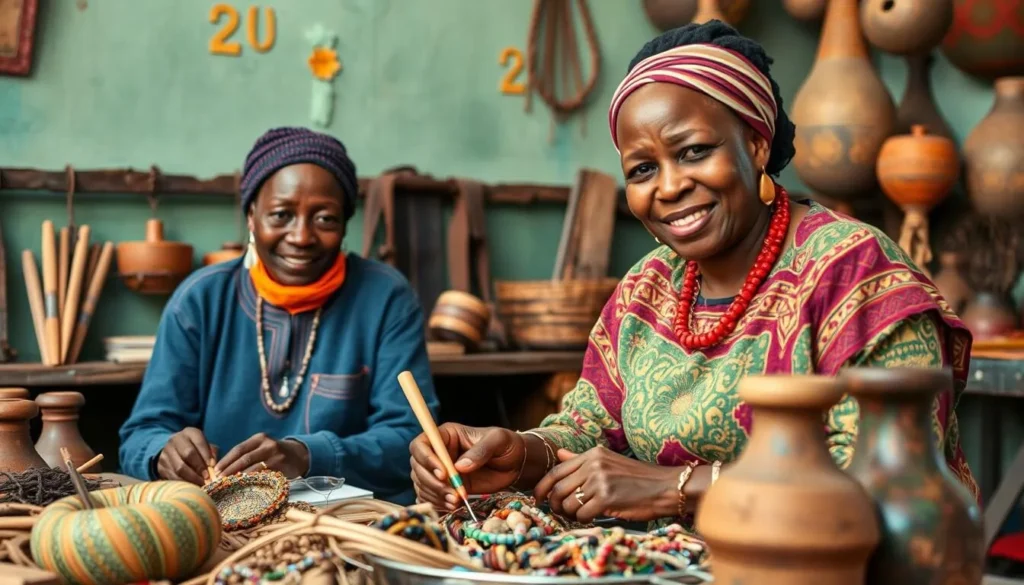
For a truly immersive cultural experience, visit the Mzilikazi Arts and Crafts Centre, where local artisans showcase their skills in traditional crafts and contemporary art. This centre is a hub for creative expression, offering a wide range of authentic Zimbabwean crafts that make for excellent souvenirs or gifts.
Traditional Crafts and Contemporary Art
The Mzilikazi Arts and Crafts Centre is renowned for its diverse collection of traditional crafts, including woodcarvings, pottery, and textiles. These items are not only beautiful but also reflect the rich cultural heritage of Zimbabwe. In addition to traditional crafts, the centre also features contemporary art pieces that blend modern techniques with traditional themes, creating a unique and captivating blend of old and new.
Supporting Local Artisans: By purchasing crafts and artwork at the centre, you are directly supporting local artisans and contributing to the continuation of Zimbabwe’s craft traditions. This makes your souvenir shopping not just a transaction, but a meaningful way to engage with and support the local community.
Shopping for Authentic Souvenirs
When shopping at the Mzilikazi Arts and Crafts Centre, it’s essential to know how to assess the quality and authenticity of the crafts and artwork. Look for items that are handmade and reflect traditional Zimbabwean designs or themes. The price ranges vary widely, from affordable trinkets to more expensive, intricate pieces. The centre accepts various payment options, making it convenient for visitors to make purchases.
Tips for Shopping: To get the most out of your shopping experience, consider commissioning custom pieces directly from the artists. This not only ensures a unique souvenir but also provides an opportunity to support local artisans directly. Additionally, don’t miss the chance to visit Bulawayo Home Industries, located in the same complex, which offers a range of batiks and woven products that complement the crafts available at the Mzilikazi Arts and Crafts Centre.
For larger items that may be difficult to transport, the centre can arrange shipping, making it easier for you to purchase and enjoy your souvenirs without the logistical hassle. Whether you’re looking for a special memento or a gift, the Mzilikazi Arts and Crafts Centre offers a memorable shopping experience that goes beyond typical souvenir hunting.
Khami Ruins: Ancient Stone Structures
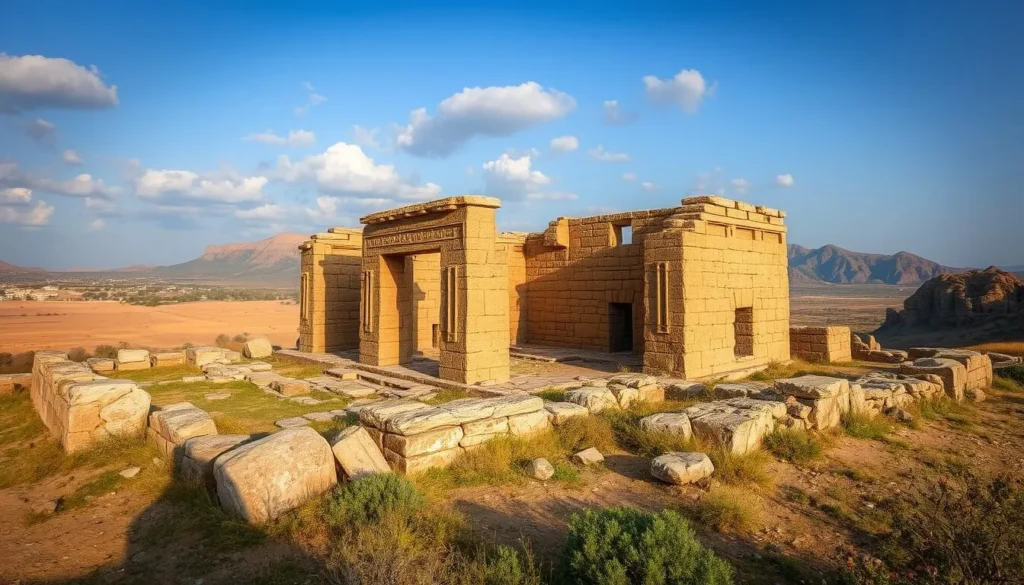
As you explore the outskirts of Bulawayo, you’ll discover the ancient Khami Ruins, a testament to the region’s rich history. This archaeological site is a must-visit destination for anyone interested in history, architecture, and culture.
Historical Significance and Architecture
The Khami Ruins are a significant historical site, showcasing the architectural styles of the people who once inhabited this region. The site features a complex of stone structures, including the Hill Complex, where the elite lived. The presence of a Portuguese Cross, with its mysterious origins, adds to the site’s historical intrigue.
The stone structures at Khami Ruins are a testament to the ingenuity and craftsmanship of the people who built them. The use of granite stones, carefully placed to form walls and passageways, is a notable feature of the site.
Visiting Tips and What to See
When visiting Khami Ruins, be sure to take a short walk up to the Hill Complex, where you can enjoy a lovely view of the hillside. The site is open daily from 8 am to 4:30 pm, and a small entrance fee is payable.
To make the most of your visit, consider arriving early in the morning or late in the afternoon to avoid the midday heat. Don’t forget to bring water, sun protection, and comfortable walking shoes. If you’re unable to visit Great Zimbabwe, Khami Ruins are an excellent alternative, offering a unique glimpse into the region’s history and culture.
Located approximately 22 km from Bulawayo on 11th Avenue Old Khami Rd, the site is easily accessible by car or public transportation. Visitors can refuel after their history walk at the picnic area under large trees.
Chipangali Wildlife Orphanage: Conservation in Action
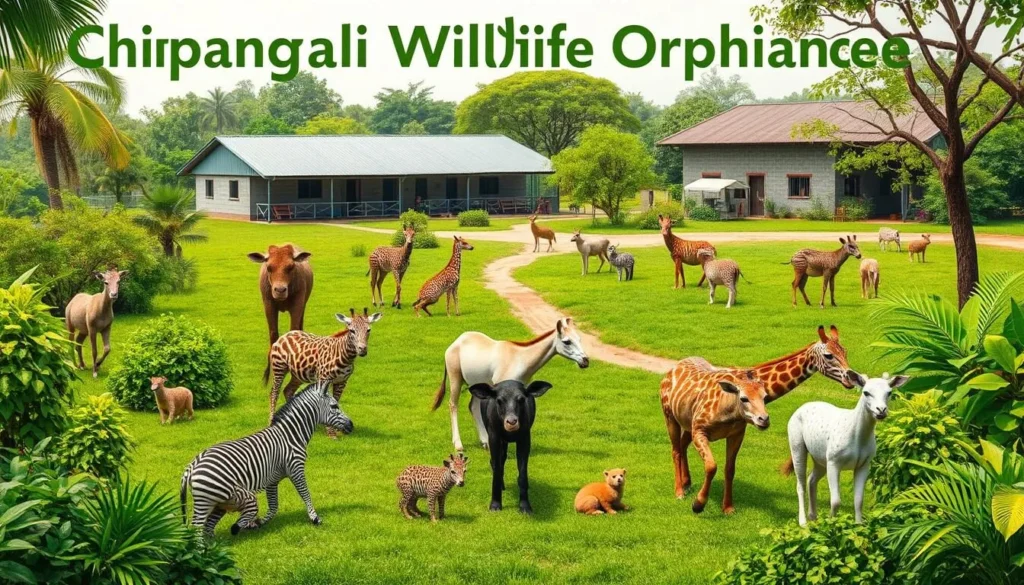
The Chipangali Wildlife Orphanage, situated approximately 25km south of Bulawayo, is a testament to conservation efforts in Zimbabwe. This remarkable facility is dedicated to rescuing and rehabilitating animals in need, providing a safe haven for those that have been orphaned or injured.
Rescued Animals and Rehabilitation Efforts
The orphanage is home to a diverse range of animals, including rhinos, antelopes, and various bird species. Visitors can observe these animals up close and learn about the rehabilitation efforts through guided tours. The dedicated team at Chipangali works tirelessly to nurse these animals back to health, with the ultimate goal of releasing them back into their natural habitats.
During your visit, you can expect to see animals at various stages of rehabilitation. The orphanage’s efforts are not only focused on the animals but also on educating the public about the importance of conservation.
Visitor Experience and Educational Programs
A visit to Chipangali is both an educational and emotional experience. The guided tours provide visitors with insights into the lives of the rescued animals and the challenges faced by the conservation team. The orphanage is family-friendly, making it an ideal destination for visitors of all ages.
The entrance fee is US $20, which is a worthwhile investment in the conservation efforts. The orphanage is open from Tuesdays to Thursdays, 9am to 5pm. Visitors can enjoy observing the animals during feeding times and other activities, making for a memorable experience.
Practical information: The orphanage is located off the Johannesburg Road, and visitors can plan their day accordingly. Facilities include refreshment options and a gift shop, enhancing the overall visitor experience.
Nesbitt Castle: A Gothic Surprise in Africa
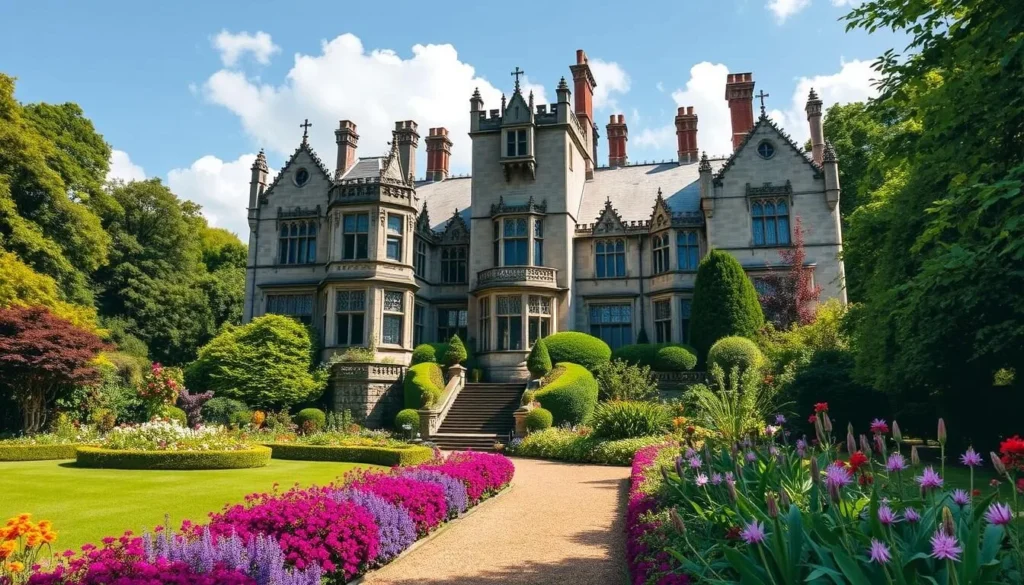
Tucked away in the heart of Africa, Nesbitt Castle is a surprising gem that showcases Zimbabwe’s architectural diversity. This Gothic Revival masterpiece has been transformed into a boutique hotel, restaurant, and pub, surrounded by lush gardens and a pony park, offering a unique experience for visitors.
The Castle’s Unique History
Nesbitt Castle’s history is as fascinating as its architecture. Originally built as a private residence, it has been meticulously restored to retain its historical charm while offering modern amenities. The castle’s transformation into a hotel and dining venue has made it a popular destination for both locals and tourists.
Dining and Accommodation Options
The castle boasts several dining options, including the Coach House Restaurant and Dragon’s Den Pub, where you can enjoy a leisurely lunch or afternoon tea. The afternoon tea experience is particularly recommended, offering a delightful way to savor the castle’s ambiance. For those wishing to stay overnight, the boutique hotel accommodations provide a romantic and memorable experience, making it an ideal venue for weddings and special occasions. You can enjoy your day at the castle by relaxing in the gardens or exploring the surrounding pony park.
Reservations are recommended, especially on Saturdays when the castle is busy with wedding parties. The castle also hosts special dining events and themed evenings, adding to its allure. Whether you’re looking for a unique dining experience or a place to stay, Nesbitt Castle is sure to leave a lasting impression.
Tshabalala Game Sanctuary: Walking with Wildlife
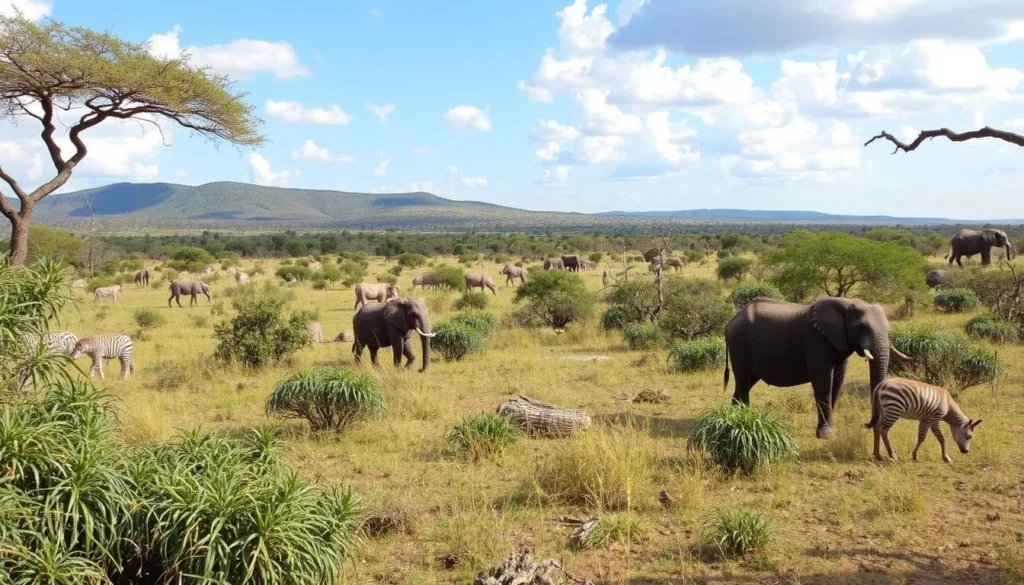
In the heart of Bulawayo lies the Tshabalala Game Sanctuary, a haven for wildlife enthusiasts. This sanctuary offers a unique opportunity to experience African wildlife in a natural setting.
Self-Guided Safari Experiences
The sanctuary allows visitors to embark on self-guided safari experiences, providing an intimate encounter with the wildlife. You can drive through the sanctuary’s trails, getting up close to animals such as giraffes, zebras, and antelopes. This flexible experience allows you to explore at your own pace.
Horseback Riding and Cycling Options
For a different perspective, the sanctuary offers horseback rides, allowing you to get even closer to the wildlife because the animals are accustomed to the horses. You can also cycle around the park if you bring your own bike. When planning your visit, remember to take your own food and drink, as well as a hat and some safari-coloured clothing to enhance your experience.
Horseback riding provides a unique perspective on the wildlife, allowing for closer encounters. It’s essential to wear comfortable clothing and shoes suitable for riding. The best time for these activities is early in the morning or late in the afternoon, avoiding the peak sun hours. This timing not only provides a more comfortable experience but also increases the chances of spotting wildlife during their most active periods.
Whether you choose to drive, ride, or cycle through the sanctuary, you’re sure to have a memorable day out in nature. The variety of exploration options caters to different fitness levels, ensuring that everyone can enjoy the beauty of Tshabalala Game Sanctuary.
Hillside Dams: Urban Nature Retreat
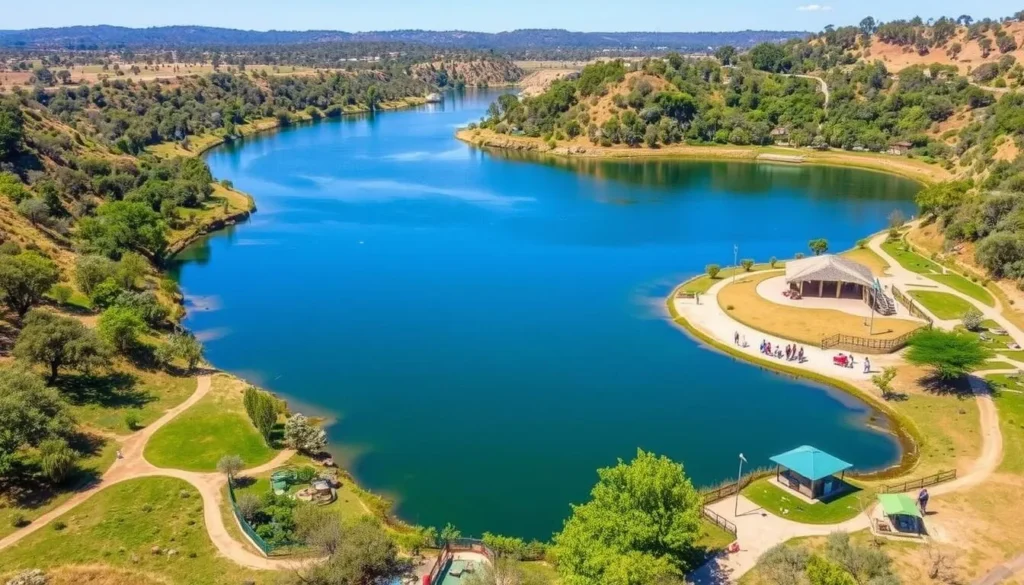
Escape to Hillside Dams, Bulawayo’s urban oasis that combines natural beauty with recreational activities. Located close to the city centre, off Banff Road, it’s an ideal spot for a day out with the family.
Walking Trails and Picnic Spots
Hillside Dams offers scenic walking trails and picturesque picnic spots, making it perfect for a relaxing outing. You can enjoy a leisurely walk around the dams, taking in the serene surroundings.
Restaurant and Recreational Activities
The on-site restaurant serves a variety of dishes, offering a range of options for a meal or a quick snack. You can enjoy your food while overlooking the dams, adding to the ambiance. Besides dining, Hillside Dams features playgrounds and other recreational facilities, ensuring there’s something for everyone.
Practical information: Hillside Dams is open daily, and there’s a small entrance fee. Facilities include restrooms and parking, making it convenient for visitors. You can plan a perfect half-day outing by combining a meal with a walk. It’s also a great venue for family gatherings or small celebrations, offering a relaxed atmosphere and good value for money.
Diana’s Pool: Natural Swimming Holes
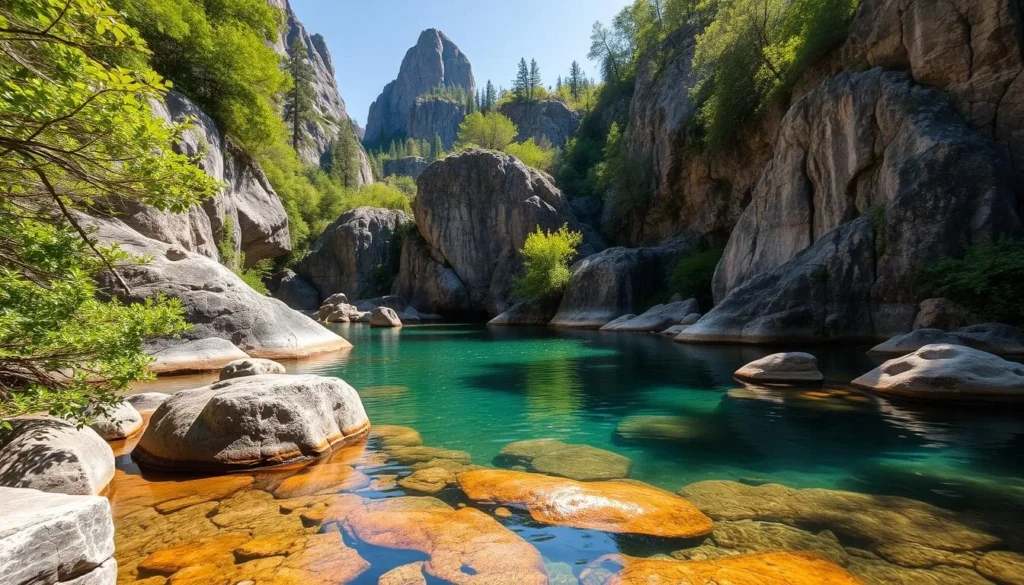
Escape to Diana’s Pool, a serene natural oasis located just 70km from Bulawayo. This picturesque destination is perfect for those seeking a tranquil retreat from the city.
Swimming and Relaxation in Granite Pools
Diana’s Pool is a family-friendly destination that offers a safe and enjoyable swimming experience. The natural granite pools are free from crocodiles and hippos, making them an ideal spot for relaxation. However, it’s essential to be aware of the potential risk of bilharzia and take necessary precautions.
Safety Tips and Best Time to Visit
When visiting Diana’s Pool, be mindful of the water depth and swim within your limits. The best time to visit is during the day when the sun is not too harsh. It’s also recommended to bring sun protection, water, and other essentials to make your visit comfortable. You can plan your visit at any time of the year, but be sure to report to the caretaker upon arrival and make a voluntary contribution for the maintenance of the area.
To ensure a safe and enjoyable experience, be aware of your surroundings and take necessary precautions. The pools are generally safe, but it’s crucial to be mindful of the water conditions and your own health.
The Bulawayo Club: Colonial Heritage
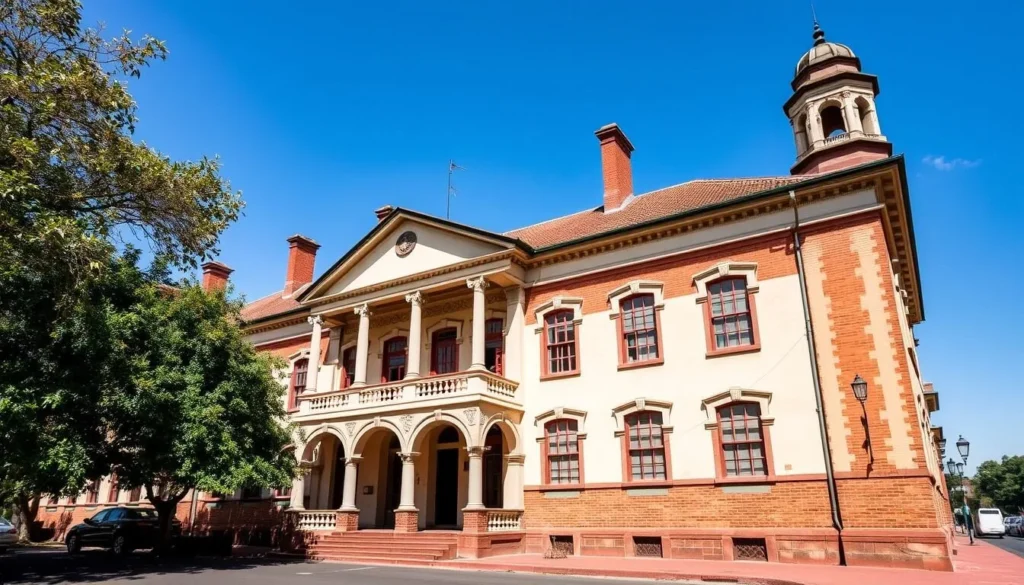
As you step into the Bulawayo Club, you are transported to a bygone era of elegance and refinement. This historic club is not just a relic of the past but a living, breathing testament to Bulawayo’s rich colonial heritage.
Historical Significance and Architecture
The Bulawayo Club is steeped in history, its architecture a blend of colonial and local influences. The building itself is a work of art, with intricate details and stately rooms that echo the elegance of a bygone era. As a hub of social activity during the colonial period, the club has played host to numerous significant events and figures in Zimbabwe’s history.
Dining Experience and Visitor Information
The Bulawayo Club is primarily a hotel, but its restaurant is open to visitors for breakfast, lunch, and dinner, offering a range of dining options that reflect both colonial and local culinary influences. You can enjoy a leisurely lunch or dinner in the club’s dining areas, which are characterized by their warm ambiance and traditional hospitality. The service is known for its quality, making the dining experience truly memorable.
For those wishing to stay overnight, the Bulawayo Club offers boutique hotel accommodations that combine comfort with historical charm. It’s advisable to make reservations in advance, especially for dinner, to ensure availability. There are no specific dress code expectations, but smart casual attire is recommended. The club also hosts special events and themed dining experiences, making it a unique destination for both locals and tourists.
Bulawayo, Zimbabwe: Best Things to Do – Top Picks for Food Lovers
As you travel Bulawayo, you’ll discover that the city’s food scene is a vibrant reflection of its cultural identity. The culinary experience in Bulawayo is a blend of traditional Zimbabwean cuisine and modern influences, offering something for every palate.
Local Restaurants and Cafés
When it comes to experiencing the authentic flavors of Bulawayo, local restaurants and cafés are the way to go. These establishments serve a range of traditional dishes, from hearty stews to grilled meats. You can enjoy your meal in a cozy atmosphere, often with a warm welcome that makes you feel like part of the family. Some popular spots are known for their traditional Zimbabwean cuisine, while others offer a more contemporary twist on classic dishes.
Many of these restaurants source their ingredients locally, ensuring that the food is fresh and flavorful. Whether you’re in the mood for something familiar or want to try something new, Bulawayo’s local eateries are a great place to explore the city’s culinary delights.
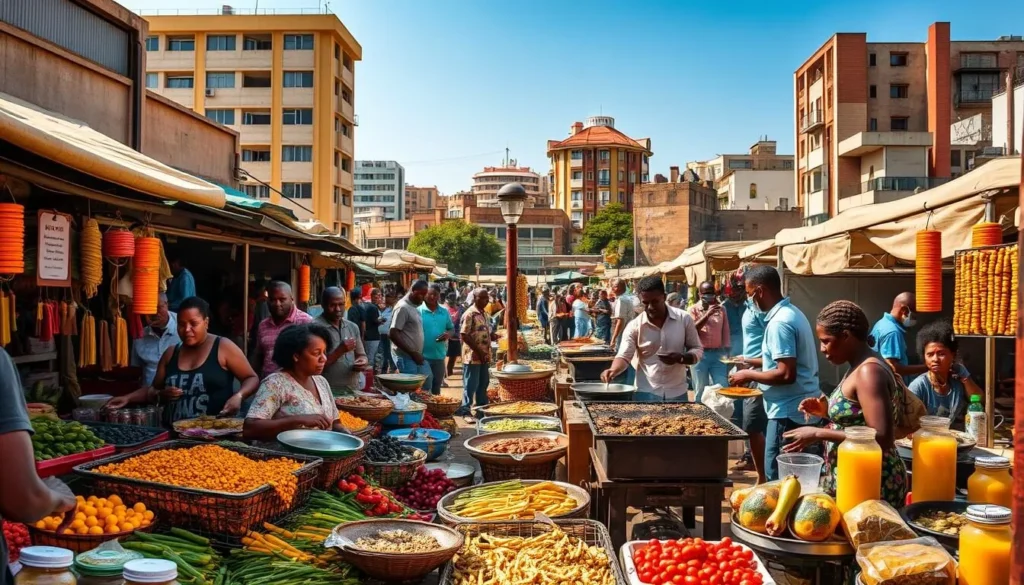
Traditional Zimbabwean Dishes to Try
Zimbabwean cuisine is characterized by its use of local ingredients and traditional cooking methods. One of the staples is sadza, a cornmeal porridge that’s often served with a variety of stews or relishes. The stews are typically made with meat or vegetables, and are flavored with local spices that add depth to the dish.
Another popular culinary tradition is nyama, or grilled meat, often enjoyed during a braai (barbecue). The slow-cooked meat is tender and full of flavor, making it a favorite among locals and visitors alike. For the more adventurous, mopane worms are a traditional protein source that’s considered a delicacy in some parts of Zimbabwe.
Traditional vegetables are also a key part of Zimbabwean cuisine, often prepared in a way that brings out their natural flavors. Local beverages, brewed using traditional methods, offer a unique taste experience that’s worth trying. Sharing meals is an important aspect of Zimbabwean culture, reflecting the community’s values of hospitality and togetherness.
When dining with locals, it’s helpful to be aware of polite eating customs. For example, it’s considered respectful to try a little of everything that’s served, as this shows appreciation for the food and the company.
Practical Information for Visiting Bulawayo
To make the most of your visit to Bulawayo, it’s vital to be informed about the practicalities. Understanding how to get around, where to stay, and the best time to visit will significantly enhance your travel experience.
Getting Around the City
Bulawayo is relatively easy to navigate, with various transportation options available. You can use local taxis, which are plentiful, or ride-hailing services. For a more independent experience, consider renting a car. Many of the city’s attractions are within a reasonable driving distance, and having your own vehicle gives you the flexibility to explore at your own pace.
- Reliable taxi services are available throughout the city.
- Ride-hailing apps offer a convenient alternative.
- Car rental services provide flexibility for exploring surrounding areas.
Accommodation Options
Bulawayo offers a range of accommodation options to suit different budgets and preferences. From luxury hotels to budget-friendly guesthouses, you’ll find something that fits your needs. Booking in advance is advisable, especially during peak travel seasons.
Tips for Choosing Accommodation:
- Consider the location in relation to the attractions you plan to visit.
- Check reviews and ratings to ensure quality and reliability.
- Look for hotels or lodges that offer additional amenities like Wi-Fi or meal services.
Best Time to Visit
The best time to visit Bulawayo is during the dry season, from May to October. The weather is mild and pleasant, making it ideal for exploring the city’s outdoor attractions. Avoid visiting during the peak summer months if you’re sensitive to heat.
Seasonal Highlights:
- Dry season (May to October): Comfortable temperatures and minimal rainfall.
- Summer months (November to April): Hot temperatures, with occasional rain showers.
Money and SIM Cards
Managing your finances and staying connected are crucial aspects of traveling. In Bulawayo, you’ll find that some ATMs accept international debit cards, although this is not common throughout Zimbabwe. It’s a good idea to have some local currency for smaller purchases and to have multiple payment options available.
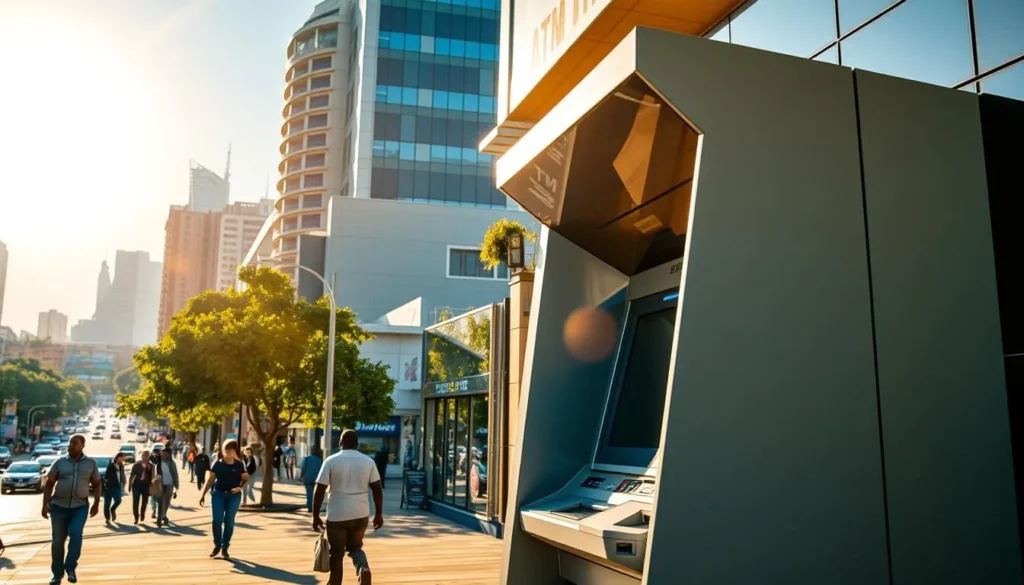
- Use ATMs that accept international cards for cash withdrawals.
- Exchange currency at reputable exchange offices for the best rates.
- Consider purchasing a local SIM card for data and calls.
For staying connected, local SIM cards are readily available, and many accommodations offer Wi-Fi. Be mindful of your data usage to avoid unexpected charges.
Day Trips from Bulawayo
Day trips from Bulawayo provide a fantastic opportunity to experience the natural beauty and history of Zimbabwe. The region is rich in cultural heritage and stunning landscapes, making it an ideal base for exploration.
Great Zimbabwe Ruins
The Great Zimbabwe Ruins are a must-visit attraction when traveling from Bulawayo. This ancient city, a UNESCO World Heritage Site, offers a glimpse into the country’s rich history. As you explore the ruins, you’ll discover the impressive stone structures that have stood the test of time. The site is not only a significant historical place but also a testament to the architectural prowess of the people who built it.
Visiting Great Zimbabwe is a unique experience that allows you to step back in time. The ruins are a window into the past, revealing the lives of the people who once inhabited this area. As you travel Bulawayo, including a visit to Great Zimbabwe in your itinerary will enrich your understanding of Zimbabwe’s history and culture.
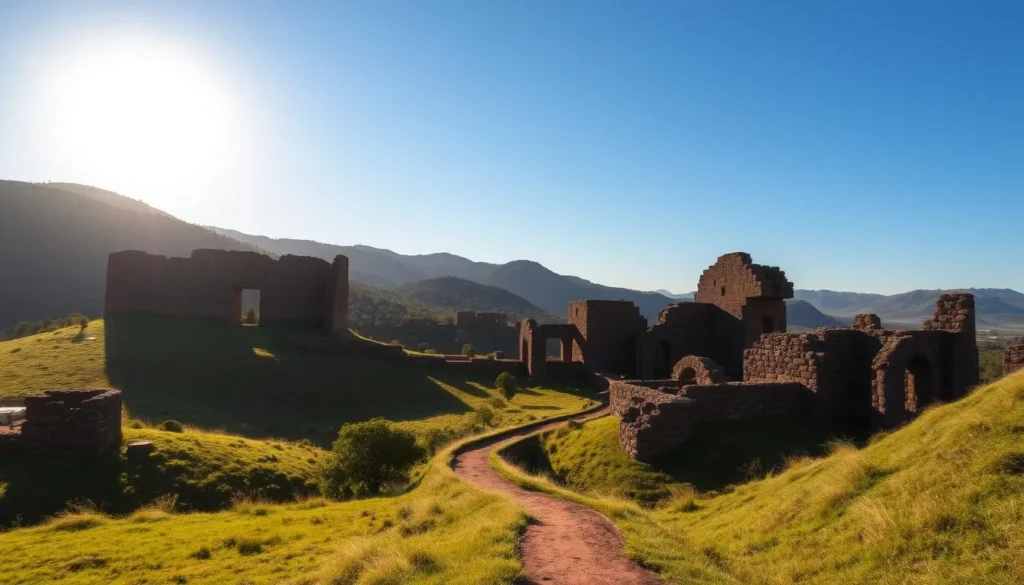
Victoria Falls: A Feasible Excursion
Victoria Falls is another incredible destination accessible from Bulawayo. Known as one of Africa’s most spectacular natural wonders, the falls are an awe-inspiring sight. You can reach Victoria Falls by road, rail, or air, making it a feasible day trip or overnight excursion. The main viewing areas offer breathtaking views of the falls, and the experience is unforgettable.
The best time to visit Victoria Falls depends on your preference for water levels. During the dry season, the falls are more exposed, while the wet season offers a more dramatic display of water cascading down. In addition to viewing the falls, you can enjoy various activities such as bungee jumping, white water rafting, and helicopter flights, making it a thrilling experience.
It’s worth noting that Victoria Falls is located on the border of Zimbabwe and Zambia, allowing you to view the falls from both sides. When planning your trip, consider the practical aspects, including entrance fees and border procedures, to ensure a smooth journey.
Conclusion: Making the Most of Your Bulawayo Experience
Bulawayo is a city that rewards exploration, with its unique blend of past and present. As you conclude your journey through this Zimbabwean city, you’ll find that it offers a rich tapestry of experiences that cater to different interests and preferences.
Diverse Experiences: From the natural beauty of Matobo National Park to the historical significance of the Khami Ruins, Bulawayo and its surroundings are replete with exciting things to see and do. You can explore the city’s museums, such as the Natural History Museum and the Bulawayo Railway Museum, or visit the Chipangali Wildlife Orphanage to learn about conservation efforts.
Cultural Significance: Bulawayo’s unique character is a blend of colonial history and African culture. The city’s architecture, museums, and cultural centers provide a glimpse into its rich past, while its vibrant markets and local artisans showcase its contemporary culture. As you travel Bulawayo, you’ll have the opportunity to engage with friendly locals and experience the city’s warm hospitality.
Practical Tips: To make the most of your visit, consider staying for at least a few days to explore the city’s hidden gems and day-trip destinations. With a well-planned itinerary, you can experience the best of Bulawayo, from its historic landmarks to its natural attractions. Whether you’re looking for a relaxing getaway or an action-packed adventure, Bulawayo has something to offer.
As you plan your trip, keep in mind that Bulawayo is an ideal base for exploring southern Zimbabwe. With its range of accommodation options and convenient transportation links, you can easily explore the surrounding region, including the Great Zimbabwe Ruins and Victoria Falls. By supporting local businesses and communities, you’ll be contributing to the local economy and promoting responsible tourism practices.
In conclusion, Bulawayo is a city that offers a unique and authentic travel experience. With its rich history, cultural significance, and natural beauty, it’s a destination that will leave a lasting impression. As you reflect on your time in Bulawayo, you’ll likely find that it was a lot more than just a stop on your journey – it was a memorable experience that will stay with you long after you leave.
The above is subject to change.
Check back often to TRAVEL.COM for the latest travel tips and deals.

